A wonderful sight early on last night, with the full Moon and Mars lying near each other, low in the sky, against the deep blue of dusk. I got a couple of shots.
A shot of the full moon rising

And a little later the Moon and Mars

Very tricky exposure conditions, I really like the sky colour that's come through.
I also had a go at Mars last night. I've gotta say it's far harder than anything else I've tried so far. I guess cos Mars is so small..
Anyway, 1000 of 2000 frames, stacked in registax. I don't know why I've got an odd halo around it, I'm suspecting something to do with the little Mak, but I'm very pleased with this for my first attempt, it's got surface detail

I also had a quick play about on a couple of lunar features, again not easy with the full moon, with the 5x barlow (even harder)... each of these is about 500 of a 1000 frames.
Aristarchus

Reiner Gamma

And I think this one is Pythagoras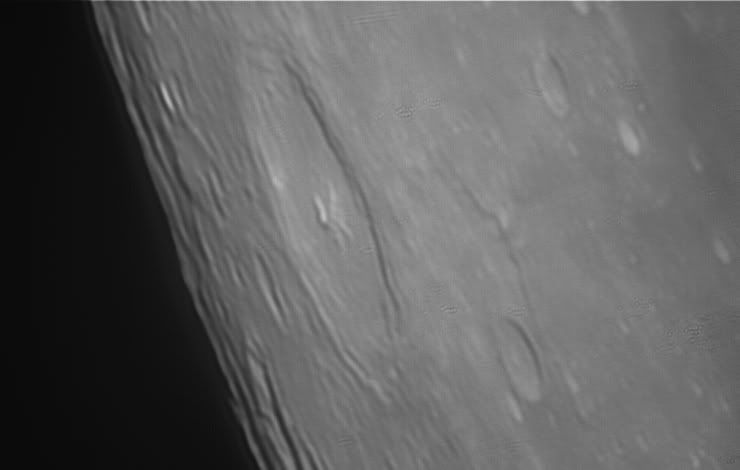
I have no intention of ever trying to do a full mosaic at this image scale, apart from being there all night, I do not have enough hard disk space to store all the AVI's...
Anyway, I used the Skymax 102 and played with different combinations of barlows... The best appears to have been a pair of 2x stacked. Focussing was really very hard.
Saturday 30 January 2010
Mars and the Moon, Mars and some Moon pieces.
Thursday 28 January 2010
Playing on the moon
Twas a clear night, but with a high mist. The mist did interfere a little, but it sure helped with the seeing... I got out for some imaging... But first, a single shot with the 450d 2xTC, the C80ED on a camera tripod.

A little later, all done, I got the kit out... The Skymax 102 with the QHY5v on the HEQ5. Using a gamepad via EQMOD to control it all (that makes life so much easier). I setup with the 2x barlow to capture a mosaic of the disk. Here's a couple of frames from the total..
Clavius

Copernicus

The full mosaic. 93 panes of 350 frames in each AVI, processed in Registax 5, merged in Imerge and tweaked in GIMP.

Click for the full size version.
I then setup with the 5x barlow for a little play, the intent being to try and image Mars. It's really hard to use, and focusing is a total mare... anyway...
Gassendi
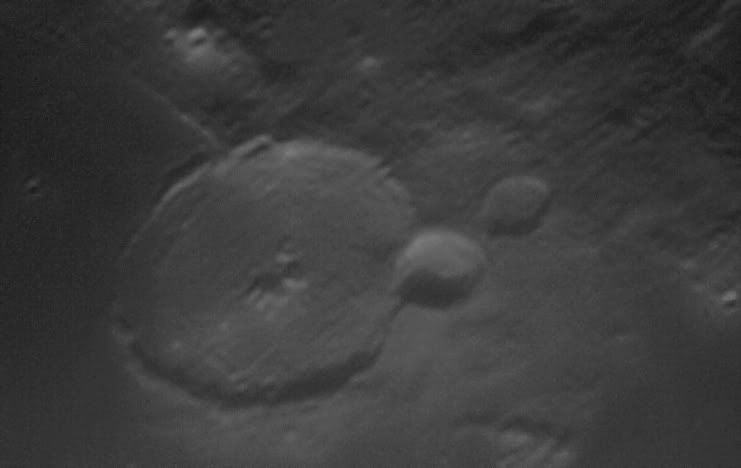
My attempts at Mars then failed completely... I couldn't find Mars, I spend some 20 minutes trying too. It wasn't that I couldn't see Mars, I could, but the very narrow FOV was just too small, then I ran out of power, and I and all my equipment needed to defrost. So it wasn't to be. Hopefully there'll be another clear night over the next week and I can have another bash at Mars.
Monday 25 January 2010
Competitions
I entered some images in Galilean nights competition last year and one of them was shortlisted....
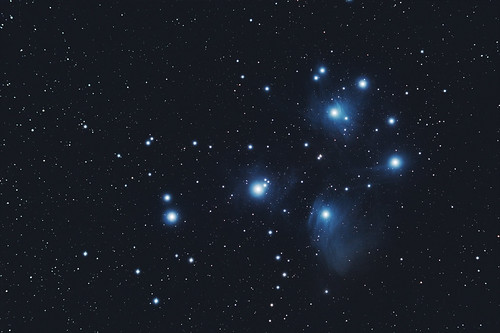
I've also pushed some images into the pool for this years Astro Photo Competition(although I've not entered yet, I'll hold off on that in case we might have a clear night over the coming months) and 2 of those have been put up on the front page as favourites

and
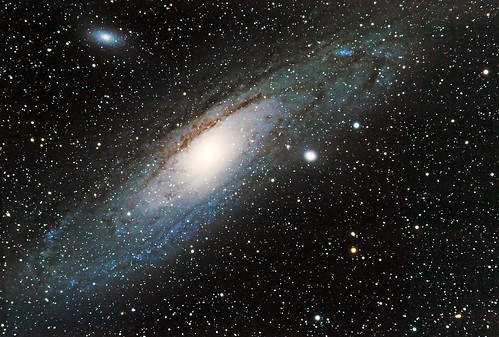
Friday 22 January 2010
A clear night
On Sunday I had a clear night that didn't have a full or nearly full moon riding high in the sky, rather a new crescent moon, and I got a couple of shots of it.
A crescent showing Earthshine, I managed to get a star in this one too, although it's quite hard to see (HP 106739, Mag 7). This was shot at 600mm with the 450d through the C80ED on my redsnapper. To be honest, I'm rather amazed the moon didn't turn into a smear, as it was quite a long exposure, but ...

And then, just the crescent at 1200mm with the 2xTC fitted too

Amazingly, the sky stayed clear of clouds, and some time later I was able to get the entire rig out. I decided to try something a little different and piggy backed the camera to the C80ED, using the Canon 50mm lens. Balance was a little tricky and I had to add the second counterweight, but once done, it worked. I'd previously made a small dew shield for the lens, but found, when firing some test shots that it was too long, so carried out some surgery on it with a pair of scissors so all's good there. Got everything lined up, set the guiding going, and the camera capturing. After 15 minutes, some odd things were going on... the mount was tracking, but the camera was stuck on a not quite blank screen... ah, I know what that is... that's the battery.. what flat already... quick change... then went to check on the guiding status. The laptop had gone into a suspend state. So I bought it back out of suspend mode, and used mains power instead. That solved that one. But PHD and EQMOD were both messed up. So start all over again.
This time all worked perfectly. And I went about capturing a sequence of 5 minute exposures.
I selected ISO200 to test out exactly what effect this would have, expecting to pick up less data. I was amazed to discover that this wasn't the case. And in fact, it's probably my best result to date.
Anyway... the image..
ISO200, 33 x 5 Minutes @ 50mm, f/3.5
Mounted on the HEQ5, guided with PHD and the QHY5v on the Vista 80s
The camera has not been modified for Ha sensitivity

Click for bigger.
I enjoyed that, and I want to have a go at Auriga next.
Thursday 14 January 2010
Reworking M45
I've never been happy with the M45 image I got last year.... It always struck me that something was missing... I had another bash last night...
I discarded the first night subs (about 12) as the alignment was totally different and was causing some difficult to process lines. Stacked, and gently gently tweaked, pushed and pulled, and after some time... ended up with ...
I'm much happier with this, although I think I might have overcooked things a little...
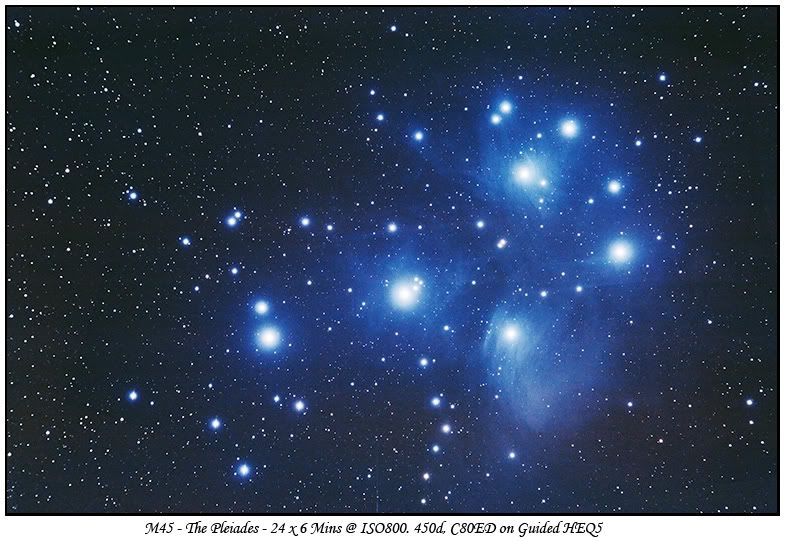
Click for a bigger version
Monday 4 January 2010
More Moons
A few moon shots from over Christmas and New Year.
From the 27th, C80ED, 2xTC and 450d on the red snapper.

and pulling out the colour

Then on New Years day, it was clear, but very very cold, I setup for a mosaic. I decided to try a full disk mosaic using the Skymax and x2 Barlow. I set for 750 frames per avi, and started capturing. After capturing the first 45 panes I realised that I was going to run out of disk space before completing (50Gb wasn't enough)... so swapped to 500 frames per avi, and started trying to process the 750 frame avi's to clear some space.
There were a few occasions throughout the evening I thought I was going to run out of sky as clouds scudded through my FOV. And I used that time to process more of the data. Anyway, I continued, only to find, later on, that I'd shot the same strip of the moon twice. I'd not realised, and it didn't show in any of the avi's but there was a little drift in the mount, that could only be seen if left alone for 10 minutes. Yet more time and space wasted (I didn't realise till I was stacking all the frames).
Then, to finish things off, prior to me completing, clouds and snow came in. There wasn't much snow, and I don't think it fell for long, but I wasn't going to risk it. So I packed up.
After finishing the processing of 102 frames, and mosaicing, I got this
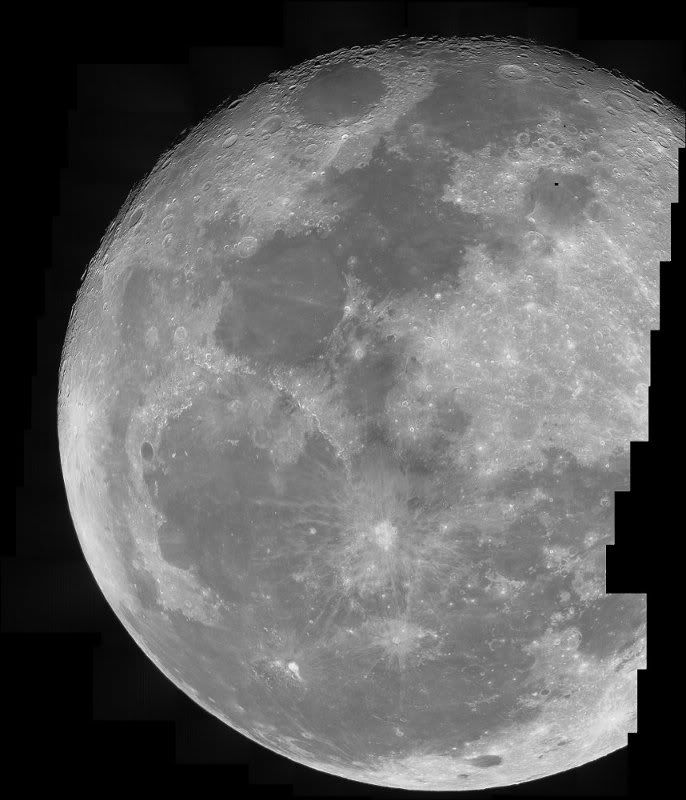
I'm pleased with how most of it turned out, just a shame about the small hole, and the remainder of the surface...
I then thought I'd put the 102 frames through MS ICE to see what would happen, and how it would come out. Here's the result, interestingly, ICE has filled in my little hole.

Click either of the above for the full size versions.
I also did a little extra processing on a small mosaic of Copernicus

and a couple of other craters and one Mare...
Mare Crisium

Langrenus

Cleomedes

Petavius

I'm sure they would have been better, had I shot longer AVI's, but I'm happy with the results. I didn't get a chance to image Mars as I'd wanted, although I'm not sure what results I would have achieved, but that's for another day.






